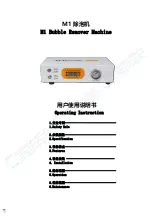
10
Operating instructions
Safety light curtain / safety light grid
SLC440 Series
SLG440 Series
EN
4. Mounting
4.1 General conditions
The following guidelines are provided as preventive warning notices
to ensure a safe and appropriate handling These guidelines are an
essential part of the safety instructions and must therefore always be
observed and respected
• The SLC/SLG must not be used on machines, which can not be
stopped electrically in case of emergency
• The safety distance between the SLC/SLG and a hazardous
machine movement must always be observed and respected
• Additional mechanical safety guards must be installed so that
the operator has to pass through the protection field to reach the
hazardous machine parts
• The SLC/SLG must be installed so that the personnel always must be
within the detection zone when operating the machine An incorrect
installation can lead to serious injuries
•
Never connect the outputs to +24VDC. If the outputs are wired to
+24VDC, they are in ON state, as a result of which they are unable to
stop a hazardous situation occurring on the application/machine
• The safety inspections must be conducted regularly
• The SLC/SLG must not be exposed to inflammable or explosive
gasses
• The connecting cables must be connected in accordance with the
installation instructions
• The fixing screws of the end caps and the mounting angle must be
firmly tightened
4.2 Protection field and approach
The protection field of the SLC consists of the entire range located
between the protection field markings of emitter and receiver Additional
protective devices must ensure that the operator has to pass through
the protection field to reach the hazardous machine parts
The SLC must be installed so that personnel are always located within
the detection zone of the safety device when operating the hazardous
machine parts to be secure
Correct installation
Hazardous machine parts can only be reached
after passing through the protection field
The presence of staff members between the
protection field and hazardous machine parts
must be prevented/avoided (protection against
stepping over)
Unauthorised installation
Hazardous machine parts can be reached
without passing through the protection field
The presence of staff members between the
protection field and hazardous machine parts is
possible
Alignment of the sensors
Procedure:
1 Emitter and receiver must be fitted parallel to each other and at the
same height
2 Choose the operating mode "Automatic" (see chapter Protective
mode/automatic) and switch the operating voltage on
3 The 7-segment display in the receiver shows the current signal
quality/fine setting (signalling, see chapter "set-up mode") for 5
minutes
At first rotate the emitter and then the receiver towards each other
until you have the best possible signal strength of 3 horizontal bars
(7 segment display) (note that 2 horizontal bars is sufficient) Fix this
position using the screws to the mounting angle
If set-up is not possible, switch to set-up mode (see chapter "set-up
mode")
The set-up mode leads to the best possible positioning of the
sensors through the basic setting (position of the second and last
beam) and the optimisation with the fine adjustment (total signal)
Status indication of the LED
OSSD ON (green) is active, signal strength (orange) is not active
4.3 Setting mode
Setting tool with 7-segment display
The function supports the best possible alignment between emitter
and receiver The indication shows the signal strength of the different
receivers while the safety outputs are switched off For the optical
indication of the signal strength two areas are available, the signal
strength of the second and the last beam in the protection zone (default
setting) as well as the best possible orientation of all beams (fine
adjustment)
Activating setting mode
After the system start, a signal impulse (H signal 24 VDC) must be
present at the input restart interlock (pin 1) of the receiver for at least
20 seconds (pushbutton/enabling)
The 7 segment display starts with the default setting (vertical bar)
The sensors are aligned in parallel and at the same height until both
segments have reached a signal strength of 50% to 100%
With a signal impulse on the input release (pin 1) you can change
between default setting and fine adjustment as long as the signal
strength is at 50% of the default setting (vertical bar)
After setting the sensors, set-up mode can be terminated by the
presence of a HI-signal at pin 1 for at least 25 seconds (max 6
seconds) and actuation of the enabling button or by a receiver system
start-up (+UB OFF/ON).
Status display
The signal strength is also shown on the display in the diagnostic
window by blue light pulses to the status light The better the alignment,
the higher the frequency of the light pulses The alignment is correct
when the light pulses switch over to continuous light
If there is no optical synchronisation between the emitter and the
receiver, a light pulse is emitted every three seconds The setting mode
is ended by a system start ( +UB OFF/ON).






































